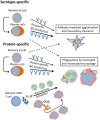The immunological mechanisms that control pneumococcal carriage
- PMID: 29267378
- PMCID: PMC5739485
- DOI: 10.1371/journal.ppat.1006665
The immunological mechanisms that control pneumococcal carriage
Abstract
Colonization of the human nasopharynx by pneumococcus is extremely common and is both the primary reservoir for transmission and a prerequisite for disease. Current vaccines targeting the polysaccharide capsule effectively prevent colonization, conferring herd protection within vaccinated communities. However, these vaccines cover only a subset of all circulating pneumococcal strains, and serotype replacement has been observed. Given the success of pneumococcal conjugate vaccine (PCV) in preventing colonization in unvaccinated adults within vaccinated communities, reducing nasopharyngeal colonization has become an outcome of interest for novel vaccines. Here, we discuss the immunological mechanisms that control nasopharyngeal colonization, with an emphasis on findings from human studies. Increased understanding of these immunological mechanisms is required to identify correlates of protection against colonization that will facilitate the early testing and design of novel vaccines.
Conflict of interest statement
I have read the journal′s policy and have the following conflicts: RM is a named inventor on filed patents related to vaccine technologies and is a scientific founder, consultant, and equity owner at Affinivax, a biotechnology company based in Cambridge, MA that is devoted to the development of vaccines for developing and developed countries. RM is also a paid consultant to Merck & Co. in the area of adult immunizations. JNW receives royalties for a pneumococcal vaccine from GlaxoSmithKline Co. JNW has a financial interest in Merck & Co., which produces a pneumococcal vaccine.
Figures

References
-
- O′Brien KL, Wolfson LJ, Watt JP, Henkle E, Deloria-Knoll M, McCall N, et al. Burden of disease caused by Streptococcus pneumoniae in children younger than 5 years: global estimates. Lancet. 2009;374(9693):893–902. doi: 10.1016/S0140-6736(09)61204-6 . - DOI - PubMed
-
- Welte T, Torres A, Nathwani D. Clinical and economic burden of community-acquired pneumonia among adults in Europe. Thorax. 2012;67(1):71–9. doi: 10.1136/thx.2009.129502 . - DOI - PubMed
-
- Krone CL, van de Groep K, Trzcinski K, Sanders EA, Bogaert D. Immunosenescence and pneumococcal disease: an imbalance in host-pathogen interactions. Lancet Respir Med. 2014;2(2):141–53. doi: 10.1016/S2213-2600(13)70165-6 . - DOI - PubMed
-
- McCullers JA. Insights into the interaction between influenza virus and pneumococcus. Clin Microbiol Rev. 2006;19(3):571–82. Epub 2006/07/19. doi: 10.1128/CMR.00058-05 . - DOI - PMC - PubMed
-
- SanJoaquin MA, Allain TJ, Molyneux ME, Benjamin L, Everett DB, Gadabu O, et al. Surveillance Programme of IN-patients and Epidemiology (SPINE): implementation of an electronic data collection tool within a large hospital in Malawi. PLoS Med. 2013;10(3):e1001400 doi: 10.1371/journal.pmed.1001400 . - DOI - PMC - PubMed
Publication types
MeSH terms
Substances
Grants and funding
LinkOut - more resources
Full Text Sources
Other Literature Sources
Medical

